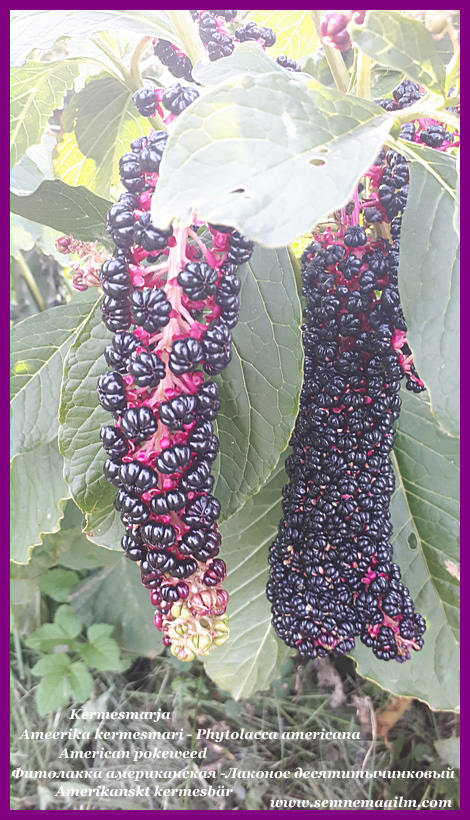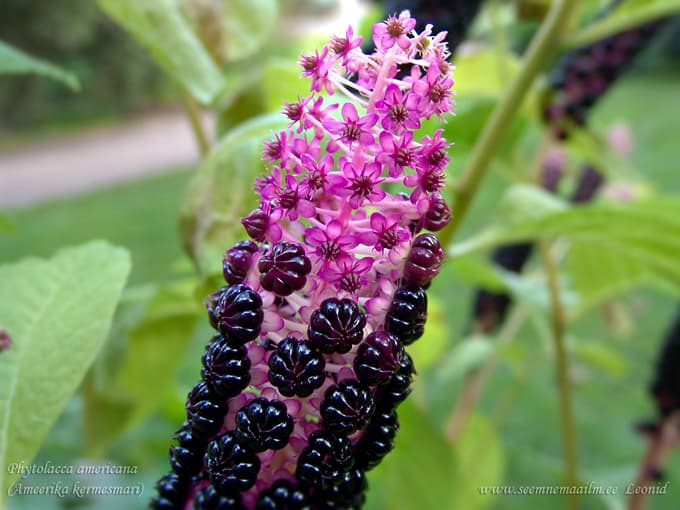Your shopping cart is empty!
American pokeweed (cancer-root, coakum, garget, inkberry, pigeon berry)
American pokeweed (inkberry, pigeon berry, pocan, poke, pokeweed, skoke, Virginia poke) - Phytolacca americana.
Perennial plant of the Phytolaccaceae family.
Origin: North America: wastelands, roadsides and forest edges.
Height of flowering plant: 180-200 cm.
Features: black berries on hanging stalks.
Flower colour: white.
Natural flowering period: June - October.
Winter hardiness zones: Z4 - Z9.
Soil requirements: average.
1.0 g = 140 seeds.

Location: the plant often suffers from spring and autumn frosts, so it is better to plant it in a place protected from cold winds.
Soil: pokeweed is not demanding to soils, it grows well both on light and medium-heavy, not too acidic (pH 5.5-6.5) soils. It is quite moisture-loving, but, having a powerful root system, provides itself with moisture well.
Care: in the fall (with the onset of frost), the stems are cut at the base and covered for the winter with peat, humus or leaves in a layer of up to 10 cm.
Reproduction: by dividing the rhizome in early spring or by seeds. They are sown freshly picked, without cleaning the pulp. The seeds are small, so they are buried in the soil shallowly.
Shoots are friendly, appear in the spring, when the ground warms up enough. Some seedlings bloom in the same year in August. In the second year, early in the spring, they are planted in a permanent place.
Use: the plants are especially beautiful in late summer and autumn, when the fleshy, juicy, glossy-black fruits ripen. Their juice is dark red (hence the name of the plant: translated from Latin, “lacca” means “red juice”). In the wine regions of Southern Europe, this juice is used to color light wines. In the US Pharmacopoeia, preparations from Phytolacca are used to treat certain diseases.
It should be remembered that all parts of the plant, including unripe berries, are poisonous.
The inflorescences last a long time when cut, and are very effective in arrangements.
Perennial plant of the Phytolaccaceae family.
Origin: North America: wastelands, roadsides and forest edges.
Height of flowering plant: 180-200 cm.
Features: black berries on hanging stalks.
Flower colour: white.
Natural flowering period: June - October.
Winter hardiness zones: Z4 - Z9.
Soil requirements: average.
1.0 g = 140 seeds.

Location: the plant often suffers from spring and autumn frosts, so it is better to plant it in a place protected from cold winds.
Soil: pokeweed is not demanding to soils, it grows well both on light and medium-heavy, not too acidic (pH 5.5-6.5) soils. It is quite moisture-loving, but, having a powerful root system, provides itself with moisture well.
Care: in the fall (with the onset of frost), the stems are cut at the base and covered for the winter with peat, humus or leaves in a layer of up to 10 cm.
Reproduction: by dividing the rhizome in early spring or by seeds. They are sown freshly picked, without cleaning the pulp. The seeds are small, so they are buried in the soil shallowly.
Shoots are friendly, appear in the spring, when the ground warms up enough. Some seedlings bloom in the same year in August. In the second year, early in the spring, they are planted in a permanent place.
Use: the plants are especially beautiful in late summer and autumn, when the fleshy, juicy, glossy-black fruits ripen. Their juice is dark red (hence the name of the plant: translated from Latin, “lacca” means “red juice”). In the wine regions of Southern Europe, this juice is used to color light wines. In the US Pharmacopoeia, preparations from Phytolacca are used to treat certain diseases.
It should be remembered that all parts of the plant, including unripe berries, are poisonous.
The inflorescences last a long time when cut, and are very effective in arrangements.

American pokeweed, poke root, American poke, cancer-root, coakum, garget, inkberry, pigeon berry, pocan, poke, pokeweed, skoke, Virginia poke. Bot. syn.: Phytolacca decandra L.












